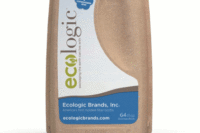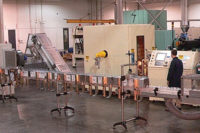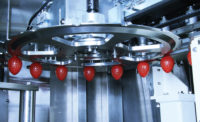Lighter is better for blow-molded bottles
Dairy processors of drinkable yogurts and other beverages seek to make bottles that weigh less. Other manufacturing concerns include reducing energy consumption.

Sidel’s dry preform and cap decontamination solutions, named Predis and Capdis, “significantly” reduce the use of chemical agents, according to the company.
Single-serve beverages, such as drinkable yogurts, meet consumers’ needs for portable snacks. Dairy processors can buy beverage bottles or produce their own on blow molding machines.
Equipment suppliers are bullish on the market for PET bottles for beverages. The Germany company KHS cites statistics from Euromonitor, a market research firm, stating the worldwide PET beverage industry will grow 4.4% a year until 2019.
Two of the most important trends in blow molding are making lighter-weight bottles and making them with in a sustainable manner, either with materials that can be recycled or with lower energy costs.
“The lighter, the better is the important thing here,” said Thomas Karell, the managing director of KHS Corpoplast GmbH. “This is why we offer many systems and solutions that pertain to the subject of lightweighting. At the same time, however, users also focus on sustainability. Lower use of energy and resources are the main demands.”
The effects of lightweighting
Using less material to blow-mold a bottle can reap significant savings for a dairy. Bruce Meyer, who calls himself the Blow Mold Doctor, said that reducing a milk or water bottle by 5 grams can save a dairy processor $20,000 to $30,000 a quarter. His assumptions include making 165,000 bottles a day for six days a week from polyethylene costing 65 cents to 70 cents a pound.
Dairies making ice teas, flavored waters or other beverages with a hot-fill process can consider rPET for blow-molded bottles. A study by Plastic Technologies Inc. concluded that using recycled polyethylene terephthalate, or rPET, in hot-fill packages has no significant adverse impact on the bottles until the blend exceeds 50%.
Innovations in blow-molding
Serac has a technology that produces bottles from pre-printed reels of polypropylene. As a result, no sleeve is required over the bottle. In 2015, the Agami technology won a World Dairy Innovations award.
The technology is used by dairy processors manufacturing drinkable yogurts. Other applications included extended shelf life and UHT flavored milks. Bottle sizes range from 100 milliliters to 500 milliliters.
Serac says its equipment saves space because the bottles go directly to the filler after being formed. A dairy does not need to store bottles or unscramble them.
Another manufacturer also serves dairy processors making drinkable yogurts and other beverages in single-serve bottles. Wilmington Machinery has a high-speed (600 bottles per minute) rotary-extrusion blow molding system for small bottles. Its SB (small bottle) technology can blow a bottle with a capture neck parison (no flash around the neck) and a mold design with no bottle knockout devices, no cut-off knives between the molds and no bottle takeout mechanism. Jeff Newman explained that the bottles are spin-trimmed and do not require deflashing.
The mold design is such that it can both trim and discharge a bottle to a bulk conveyor without the need of pneumatic knockout system. The mold and process design blows and cools 100% of the flash, eliminating the risk of the bottles sticking together prior to trimming, Newman said. Wilmington offers the technology for multi-layer and dual parison applications, with plans to offer a three-parison configuration.
Food safety on the line
Food safety is on the minds of dairy processors. KHS offers a new inspection system that detects foreign objects, leaks and other defects in preforms. Named Innocheck PPI (for PET preform inspection), the equipment is integrated into a stretch blow molder’s preform separator where it assesses the quality of the sealing surface. An imaging camera is used to detect distortions or contamination. Software can evaluate and inspect up to 81,000 preforms an hour. Faulty preforms are rejected prior to stretch blow molding. The device is integrated into KHS’ Blomax models and can be retrofitted into Series IV machines.
Dairy beverages, like milk and yogurts, require special care in order to achieve their expected shelf-life and to protect their quality, taste and vitamin content. These products can more easily suffer microbiological decomposition due to changes in light, oxygen or temperature, according to Sidel.
In its pilot plant for aseptic production, Sidel reproduces all the steps — from processing to filling — found in a full dairy plant. This allows it to recommend appropriate materials, bottle weight and shape, and blowing and filling technologies.
Sidel also offers dry preform and cap decontamination solutions that do not use water during production. The solutions replace bottle rinsing with dry preform sterilization using hydrogen peroxide vapor.
The Italian dairy processor Parmalat installed an injection preform system, or IPS, platform at its Piana di Monteverna plant in Italy. The processor uses PET preforms from Sacmi to manufacture lightweight 1-liter bottles from a 48-cavity injection mold. The IPS 220 is an integrated platform that can shorten preform production cycles, according to Sacmi.
Edited by Dairy Foods from information submitted by equipment suppliers.
Blow molding offers flexibility and automation
By Maria Ferrante, PMMI
Consumer focus on healthy lifestyle, environmentally conscious packaging, personal choice, convenience and value are driving advances in the dairy packaging market, particularly in the area of blow-molded bottles.
Today’s consumers are proactive – and even progressive – in their approach to health and wellness, according to the Hartman Group, a market research firm. These consumers embracing the healthy lifestyle trend see milk and other liquid dairy products (LDP) as an important part of this journey.
With the popularity of LDP, consumers are also asking for dairy packaging that is environmentally conscious, increasing the importance of sustainability. This translates to a reduction in packaging and increased use of recycled materials. Reduced energy costs are also important, but processors insist these savings must not impact the flexibility of the machinery or the design of the product.
These requirements have led processors to look closely at the use of multi-layer packaging. Blow-molded high-density polyethylene (HDPE) bottles are a popular choice for milk and other liquid dairy products.
Extrusion blow molded HDPE bottles are appropriate for packaging many types of milk products, irrespective of its treatment (pasteurized, UHT or sterilized). The flexibility of the production process makes it possible to combine different materials to achieve desired properties. Barrier layers can be integrated and recycled materials used without issue. At the same time, the extrusion blow molding process offers a variety of design options, with the capability to produce a wide range of shapes, structures and colors.
And while blow molding provides the desired flexibility, automation is also a key innovation for all types of dairy packaging equipment, according to PMMI’s 2016 Dairy Market Assessment Report. The increase in automation is driven by the following factors:
- Production efficiency improvements and greater cost efficiency, particularly in developed markets where labor costs are higher.
- A growing use of big data and intelligent machines in all areas of manufacturing.
- The need for automated track-and-trace capabilities that help limit contamination and disease outbreaks.
- New regulations such as the Food Safety Modernization Act (FSMA) that require extensive documentation, prompting the need for automated machines that can provide real-time documentation of production information.
Dairy processors looking to respond source effective packaging solutions should plan to attend Pack Expo East 2017 from Feb. 27, 2017 to March 1 at the Pennsylvania Convention Center in Philadelphia. The show will feature more than 400 exhibitors in nearly 100,000 net square feet. ProFood Tech (April 4-6, 2017, McCormick Place, Chicago), is another place to see blow-molding machinery.
— Maria Ferrante is PMMI’s senior director of marketing and communications.
Looking for a reprint of this article?
From high-res PDFs to custom plaques, order your copy today!








